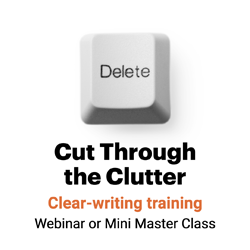Readable messages help everyone
I recently attended a conference where the Nielsen Norman Group unveiled its latest eyetracking research. After more than 20 years in the lab, watching people read and respond to text, they reported this finding:

“This is too easy to read.”
— Nobody ever
Literally, in decades of research, nobody has ever told them that, including highly educated domain experts.
Nobody wants it to be harder.
Some of your audience members can’t read very well, according to the latest worldwide literacy study.
But what about those who do have the skills to read easily?
But that’s not my audience.
It never fails.
When I talk in my writing workshops about the importance of making copy easy to read and understand, there’s always one person who can’t believe the advice applies to her.
“Are you kidding?” she gasps. “I’m writing to executives/pharmacists/school district superintendents/telecomm engineers/financial planners/horse breeders. These folks are superbly educated, brilliant and divine. There’s no way they’ll read anything that easy.”
So you think your audience wants it to be harder? Think again.
I’ve always argued that if you think your audience members are especially elevated or educated, then you should make your copy more readable. Executives, surgeons and other highly educated readers, after all, tend to have more stuff to read and less time to read it. So we need to make messages for those folks even easier to process.
But even if you’re writing to brain surgeons, you still want to keep your readability in check. That’s because:
1. People don’t read at their grade level. On average, high school graduates read at the 9th grade level, according to William H. Dubay, readability consultant at Plain Language Services.[1]
College graduates prefer to read at the 10th-grade level, but may be willing to read information in their own fields at a higher level.
2. Reading skills decline over time. Plus, reading skills decline over time. According to the PIAAC, reading and numbers skills:
- Increased from the teenage years through the mid 40s
- Plunged some 25 points between the 40 to 54 age group and the 55 to 64 age group
- Dropped 30 more points between the 55 to 64 age group and the oldest adults
That’s partly because seniors, on average, spent fewer years in school than young people. In fact, one-third of Americans age 65 or older fall into the lowest level of prose literacy.
On average, adults read at 5 grade levels lower than the last grade they completed.
3. People don’t want to read at their grade level. People don’t want to read at their grade level.
As Douglas Mueller, president of the Gunning-Mueller Clear Writing Institute, says:
“People prefer to read and get information at a level below their capacity. Even a Harvard University professor prefers to get information without strain.”
Nobody wants it to be harder. In this environment, how do you reach real readers — those who can’t read, or just don’t want to read, at higher grade levels?
Make your message more readable. Because readability helps everyone.
Readability helps everyone
Readability helps everyone — from Harvard University professors to brain surgeons to rocket scientists. Or so says a new study by the Nielsen Norman Group.
NNG researchers started with an off-the-shelf pharmaceutical ad. You know how hard those are to read, what with all of the legalese, caveats and disclaimers. Then the researchers had two groups of people — highly literate folks and those with lower literacy — read the ads and answer some questions.
Highly literate group performs better. Unsurprisingly, in the first test, the highly literate group outperformed those with low literacy on all three measures of success:
1. Understanding. People with higher literacy understood the message better.
- The low-literacy group answered 46% of the questions right.
- The highly literate group answered 82% correctly.
2. Task time. People with higher literacy read the message faster.
- Those with low literacy took 22 minutes to read the ad.
- The highly literate group took only 14 minutes to read it.
3. Satisfaction. Nobody likes reading a pharmaceutical ad. But the low-literacy group enjoyed the experience even less than those with high literacy.
- Those with lower literacy scored their satisfaction 2.5 on a scale of 1 to 10.
- The highly literate group gave the experience a 3.7 out of 10.
Then the folks at the Nielsen Norman Group rewrote the ad. They used shorter sentences, shorter words and explanatory graphics to increase readability.
Highly literate perform even better. Unsurprisingly, the low literacy group performed significantly better on the more readable ad. The real surprise was that the highly literate group also performed much, much better with more readable copy.
1. Understanding. Both groups understood the clearer message better:
- The low-literacy group answered nearly half again as many questions correctly — 68%, compared to 46%. That’s a 48% increase.
- The highly literate group understood the more readable ad 13% better, answering 93% of the questions correctly, compared to 82%.
Do you really want your highly educated readers to misunderstand 13% of your message?
2. Task time. Both groups read the more readable message faster:
- Those with low literacy took only 10 minutes to read the revised ad, down from 22 minutes for the more difficult one. That’s a 55% increase in reading speed.
- The highly literate group saved nine minutes on the revised ad, finishing it in five minutes, down from 14.
That’s a 64% increase.
Give me my nine minutes back! Nobody wants to spend more time reading your message, especially not your super-busy highly literate readers.
3. Satisfaction. Even when it’s better written, nobody enjoys reading a pharmaceutical ad. But both groups preferred reading the revised message to the original:
- Those with lower literacy liked reading the revised ad 76% more, increasing their score from 2.5 to 4.4 on a scale of 1 to 10.
- The highly literate group liked reading the revised ad 30% more, boosting their satisfaction score from 3.7 to 4.8.
Remember, in all of the Nielsen Norman Group’s research, not one single person has ever wished that anything was harder to read. Repeat after me:
“My audience is not the exception.”
Nobody wants it to be harder.
So how do you make your message easier to read and understand for all of your readers, no matter what level they read at (or want to read at)?
Whether you’re writing blog posts, content marketing pieces or news releases, you can improve your Flesch Kincaid grade level scores and other readability formulas by doing two things:
- Write short sentences: Learn how to reduce your sentence length and improve your sentence structure to make messages easier to understand.
- Reduce word length: Learn how to reduce syllables per word and write in plain English for good readability.
Do that, and watch your writing readability text soar.
Because nobody wants it to be harder.
Learn more:
- Improve your Flesch Kincaid reading level score for more readable messages.
- Nail the Flesch Reading Ease test to make difficult-to-read copy easier to understand.
- Make any piece of text more readable by boosting readability scores.
____
Source:
[1] William H. Dubay, The Principles of Readability, Impact Information, Aug. 25, 2004, p. 7

Leave a Reply